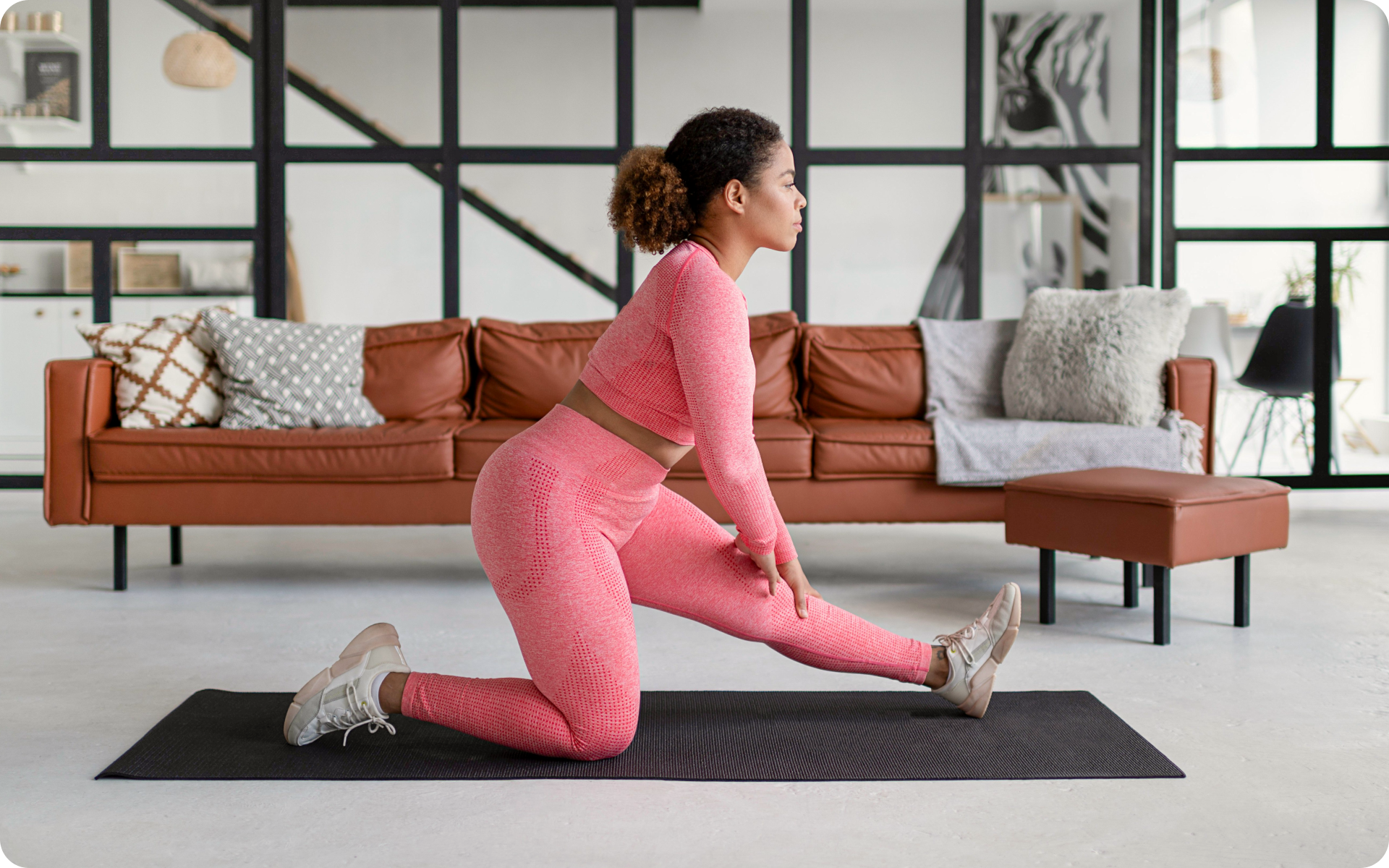Thigh fat— or any kind of body fat for that matter — can be challenging to get rid of. In fact, it can be downright frustrating. You may feel like you’re doing everything right— eating healthy, working out regularly —but those stubborn pounds just don’t seem to budge!
Many women store fat in their thighs due to genetics. Hormones that promote fat storage can also cause trouble with weight loss.
What can you do to lose thigh fat? First, understand that spot-reducing, or targeting specific body parts with exercises, isn’t possible. You can’t just do a bunch of leg lifts and hope that your thighs will slim down.
The most effective way to lose weight is to create an energy deficit by burning more calories than you consume. This means you need to focus on overall weight loss.
Read on for some specific strategies that can help you slim down your thighs and keep the weight off – for good.
Is It Possible To Lose Thigh Fat In 2 Weeks?
It’s possible to create habits that will help you lose fat in just 2 weeks, but it’s unlikely that you’ll be able to specifically target thigh fat nor that you’ll see visible results in that amount of time. Losing weight and reducing body fat takes time and consistent effort, and everyone’s body is different.
Understanding Body Fat
Body fat is an essential part of our body composition. It provides insulation and energy storage, and helps protect our organs. However, excess body fat can lead to health issues and affect our overall appearance. Body fat is distributed throughout the body, but some areas tend to store more fat than others. This is largely influenced by genetics and hormone levels.
Spot Reduction is a Myth
There’s a common misconception that doing specific exercises will reduce fat in that specific area. For example, doing squats or lunges will reduce thigh fat. This is known as “spot reduction,” and unfortunately, it’s a myth. While targeted exercises can help tone and strengthen specific muscles, they won’t necessarily reduce fat in that area (6).
If you struggle to even flirt with the idea of giving up your favorite foods or working out till your legs give way – BetterMe app is here to breathe a fresh perspective into the way you view the weight loss process! Check out the app and experience the fun side of fitness and dieting with BetterMe!
How Do You Lose Thigh Fat In A Week?
You don’t! Fat loss is an intricate, slow process that happens when you create an energy deficit by eating fewer calories than you burn. There’s no way to lose significant amounts of weight in just a week or two.
When you create an energy deficit, your body starts to burn stored fat for energy (6). However, this doesn’t happen overnight, as it takes time for your body to tap into its fat stores.
That’s why sustainable weight loss is slow and steady— usually 1 to 2 pounds per week (10). And that’s also why crash diets or other quick-fix solutions are rarely effective in the long run.
Here’s what will help you lose 3 or more inches off your thighs and maintain a toned appearance:
1. Cut Calories To Lose Weight
The most important step in losing weight— and, really, the only step —is to create an energy deficit by burning more calories than you consume (6). This means that you need to focus on overall weight loss.
To do that, you’ll need to cut calories. The best way to do that is to follow a healthy diet and make sure that you’re eating fewer calories than you’re burning (25).
More specifically:
- Determine your daily calorie needs. This will give you a starting point for how many calories you should be eating each day.
- Cut 500 to 750 calories from your daily intake. This will help you create the energy deficit needed to lose weight.
- Cut back on high-calorie, low-nutrient foods. Processed foods, sugary drinks, and refined carbs– are empty calories that can add up quickly (19).
- Limit your intake of saturated and unhealthy fats. These can contribute to weight gain and increase your risk of chronic diseases (7).
- Eat more fruits, vegetables, whole grains, and lean protein. These are nutrient-rich foods that will help you feel fuller and more satisfied (13).
2. Exercise Regularly To Burn Calories And Tone Your Thighs
In addition to cutting calories, you need to burn calories through exercise to lose weight (21).
Aim for at least 150 minutes of moderate-intensity cardio per week. This can include activities like brisk walking, biking, swimming, or jogging.
If you want to see more specific results, add 2 or 3 strength-training sessions to your weekly routine as well. This will help you build muscle, which can make your thighs look toned and shaped (16).
Some exercises that target the thighs include:
Barbell Squats
Barbell squats are a great exercise for toning the thighs. They work the quadriceps, hamstrings, and glutes— all of which are large muscle groups in the thighs.
How to do it:
- Position a barbell on your upper back with hands gripping the bar and stand with your feet hip-width apart.
- Keeping your back straight and your core engaged, lower into a squat until your thighs are parallel to the floor.
- Push through your heels to return to a standing position.
- Repeat for 8 to 12 reps.
Lunges
Lunges work the same muscle groups as squats, but they also target the adductor muscles— the muscles on the inside of the thighs.
How to do it:
- Start by standing with your feet together.
- Step forward with one leg and lower into a lunge, keeping your front knee behind your toe.
- Push through your front heel to return to a standing position.
- Repeat with the other leg.
- Continue alternating for 8 to 12 reps on each side.
Leg Presses
Leg presses are a great machine-based exercise for toning the thighs. They specifically target the quadriceps, which are the large muscles on the front of the thighs.
How to do it:
- Sit in a leg press machine with your back flat against the pad and your feet hip-width apart on the footplate.
- Release the safety lever and lower the weight until you are in a deep squat position.
- Push through your heels to return to the starting position.
- Repeat for 8 to 12 reps.
Sumo Squats
Sumo squats are similar to regular squats, but they place a greater emphasis on the inner thighs.
How to do it:
- Start by standing with your feet wider than hip-width apart, toes pointed out at a 45-degree angle.
- Lower into a squat until your knees reach a 90 degree angle, keeping your weight in your heels.
- Push through your heels to return to standing.
- Repeat for 8 to 12 reps.
Read more: Is The Japanese Towel Exercise an Effective Way to Burn Belly Fat?
3. Incorporate HIIT Into Your Workouts
In addition to traditional cardio and strength training, you may also want to incorporate high-intensity interval training (HIIT) into your workout routine.
HIIT is a type of exercise that alternates between short bursts of intense activity and periods of rest. It’s an effective way to burn calories, which can help you see results more quickly (8).
To try HIIT, you can do any type of cardio workout such as running, biking, swimming, rowing, etc. The key is to alternate between periods of all-out effort and active rest.
For example, you might sprint for 30 seconds, then walk for 60 seconds. You can do this for 10 to 20 minutes at a time, depending on your fitness level.
4. Consider The Role Hormones Play
As mentioned earlier, hormones can play a role in where your body tends to store fat. If you struggle with thigh fat specifically, it may be due to hormonal imbalances (20).
For example, polycystic ovary syndrome (PCOS) is a condition that’s characterized by high levels of testosterone. PCOS can lead to weight gain and difficulty losing weight, particularly in the thighs and lower body (11).
Other hormonal conditions that may contribute to thigh fat include (2) (18):
- Cushing’s syndrome
- Hypothyroidism
- Estrogen dominance
If you suspect that hormones are playing a role in your weight gain, talk to your doctor. They can order tests to determine if you have a hormonal imbalance.
There are also some hormones, not specific to the female population, that play a role in how body fat is distributed.
For example, insulin is a hormone that helps the body use blood sugar for energy. When levels are high, it can lead to weight gain, particularly in the form of belly fat.
Cortisol is another hormone that’s closely linked to stress. High levels of cortisol have been linked to increased appetite and cravings, as well as weight gain (17).
Whether you’re a workout beast or just a beginner making your first foray into the world of fitness and dieting – BetterMe has a lot to offer to both newbies and experts! Install the app and experience the versatility first-hand!
5. Practice Sleep Hygiene
Poor sleep is closely linked to weight gain and obesity (15). In fact, one study found that women who slept fewer than 7 hours per night were more likely to be obese (1).
Lack of sleep can lead to an increase in the hunger hormone ghrelin and a decrease in the satiety hormone leptin, which can make you eat more and gain weight (14).
To promote healthy sleep habits, aim for 7 to 9 hours of sleep per night and practice good sleep hygiene. This means setting a regular sleep schedule, avoiding caffeine and electronics before bed, and creating a relaxing bedtime routine.
6. Manage Stress Levels
Like poor sleep, stress can also contribute to weight gain. When you’re stressed, your body releases the hormone cortisol. As mentioned earlier, high levels of cortisol have been linked to increased appetite and cravings, as well as weight gain (3).
To manage stress, consider incorporating some or all of the following into your routine:
- Yoga
- Meditation
- Deep breathing exercises
- Exercise
- Spending time in nature
- Journaling
- Spending time with friends and family
Read more: 24 Weight Loss Smoothies, 2 Diet Plans, and 5 Belly Fat Smoothie Secrets
FAQs
Is It Harder To Lose Thigh Fat Than Other Areas?
Some people may be genetically predisposed to store more fat in their thighs, making it harder for them to lose thigh fat. Thigh fat may also be harder for women to lose than men due to hormonal differences. Women typically have a higher percentage of body fat than men, and it’s primarily stored in the hips, thighs, and buttocks.
Thigh fat is typically white fat. A type of fat that serves as an energy storage and insulation. Unlike brown fat, which is metabolically active and helps burn calories to generate heat, white fat is less active and tends to accumulate in certain areas of the body. This explains why it can be difficult to lose thigh fat, compared to other areas.
Recent studies have suggested that certain activities, such as regular exposure to cold temperatures and engaging in physical exercise, can stimulate the conversion of white fat into beige fat—a type of fat with properties similar to both white and brown fat (4).
Beige fat cells can burn calories and have been linked to improved glucose metabolism and insulin sensitivity. Thus, the process of losing fat, whether it’s thigh fat or elsewhere, is influenced not only by hormonal and genetic factors but also by how effectively these different types of fat are mobilized and utilized by the body.
Can Walking Reduce Thigh Fat?
Walking can reduce thigh fat by burning calories and increasing muscle mass in the legs. While you walk, your body needs to work harder to propel your legs forward, which burns more calories, compared to simply standing or sitting. In addition, walking can also help build muscle in the thighs, as the muscles are activated and strengthened during this activity (24).
For walking to effectively reduce thigh fat, it should be paired with a low-calorie, healthy diet. This will create a calorie deficit that can lead to overall weight loss, including in the thighs (12). Additionally, adding resistance training exercises such as squats and lunges can further target and tone the thigh muscles.
Are My Thighs Fat Or Muscle?
Thighs have both fat and muscle tissue, so they can appear larger or smaller depending on the ratio of fat to muscle. If you have a higher percentage of body fat, your thighs may appear bigger and “flabbier.” However, if you engage in strength training exercises that target the thigh muscles, you can increase their size and definition.
Having some amount of fat is necessary for the body to function properly. The key is maintaining a healthy balance between muscle and fat. This can be achieved through regular physical activity, a balanced diet, and monitoring overall body composition (the ratio of lean tissue to fat tissue in the body).
How Can I Slim My Thighs Without Exercise?
While exercise is one of the most effective ways to slim down thighs, there are some other tips that can help in achieving slimmer thighs without exercise. Here are a few suggestions:
- Watch your diet: Eating a healthy, balanced diet low in calories and high in nutrients can help you lose fat from your thighs (and overall body) without needing to exercise (12).
- Stay hydrated: Drinking enough water can help the body function properly, reducing water retention in the thighs and helping them appear slimmer (23).
- Avoid processed foods: Processed foods are often high in unhealthy fats and added sugars, which can contribute to weight gain (5). Opt for whole, unprocessed foods instead.
- Get enough sleep: Lack of sleep has been linked to weight gain and can also increase cravings for unhealthy foods. Aim for 7-9 hours of sleep each night (22).
- Try massage therapy: Some studies have shown that specific types of massage, such as deep tissue or lymphatic drainage massage, can help reduce thigh circumference and improve overall body composition (9).
The Bottom Line
Stubborn thigh fat can be tough to get rid of. However, by making small changes to your diet and lifestyle, you can see results more quickly. Try incorporating some of the tips above into your routine and be patient as you work towards your goals. Remember, slow and steady wins the race.
DISCLAIMER:
This article is intended for general informational purposes only and does not serve to address individual circumstances. It is not a substitute for professional advice or help and should not be relied on for making any kind of decision-making. Any action taken as a direct or indirect result of the information in this article is entirely at your own risk and is your sole responsibility.
BetterMe, its content staff, and its medical advisors accept no responsibility for inaccuracies, errors, misstatements, inconsistencies, or omissions and specifically disclaim any liability, loss or risk, personal, professional or otherwise, which may be incurred as a consequence, directly or indirectly, of the use and/or application of any content.
You should always seek the advice of your physician or other qualified health provider with any questions you may have regarding a medical condition or your specific situation. Never disregard professional medical advice or delay seeking it because of BetterMe content. If you suspect or think you may have a medical emergency, call your doctor.
SOURCES:
- Association between Reduced Sleep and Weight Gain in Women (2006, academic.oup.com)
- Cushing’s Syndrome Effects on the Thyroid (2021, mdpi.com)
- Effects of Chronic Social Stress on Obesity (2012, link.springer.com)
- Effect of Intermittent Cold Exposure on Brown Fat Activation, Obesity, and Energy Homeostasis in Mice (2014,nih.gov)
- Eating highly processed foods linked to weight gain (2019,nih.gov)
- Fat loss depends on energy deficit only, independently of the method for weight loss (2007, pubmed.ncbi.nlm.nih.gov)
- Fats, Cholesterol, And Chronic Diseases – Eat for Life (1992, ncbi.nlm.nih.gov)
- High-Intensity Intermittent Exercise and Fat Loss (2015, hindawi.com)
- Lymphatic Drainage Massage (2021,clevelandclinic.org)
- Losing Weight | Healthy Weight, Nutrition, and Physical Activity (2022, cdc.gov)
- Obesity and Polycystic Ovary Syndrome: Implications for Pathogenesis and Novel Management Strategies (2019, ncbi.nlm.nih.gov)
- Optimal Diet Strategies for Weight Loss and Weight Loss Maintenance (2021,nih.gov)
- Optimising foods for satiety (2018, sciencedirect.com)
- Short Sleep Duration Is Associated with Reduced Leptin, Elevated Ghrelin, and Increased Body Mass Index (2004, journals.plos.org)
- Sleep and obesity (2013, ncbi.nlm.nih.gov)
- Strength training: Get stronger, leaner, healthier (2021, mayoclinic.org)
- Stress, cortisol, and other appetite‐related hormones: Prospective prediction of 6‐month changes in food cravings and weight (2017, onlinelibrary.wiley.com)
- The Estrogen Hypothesis of Obesity (2014, journals.plos.org)
- The Hidden Dangers of Fast and Processed Food (2018, ncbi.nlm.nih.gov)
- The influence of sex hormones on obesity across the female life span (1998, pubmed.ncbi.nlm.nih.gov)
- The Role of Exercise and Physical Activity in Weight Loss and Maintenance (2015, ncbi.nlm.nih.gov)
- Weight Loss and Sleep (2023,sleepfoundation.org)
- Will Drinking More Water Help With Edema? (n,d,medicinenet.com)
- Walking (2022,cdc.gov)
- Weight-Loss and Maintenance Strategies – Weight Management (2004, ncbi.nlm.nih.gov)










